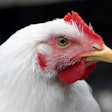
Broiler house stocking density is becoming an increasingly controversial issue in poultry welfare. However, reducing the number of birds within a given space can impact the financial viability of an operation. The key is understanding the true space needs of poultry.
Perception changes reality
The initial response of the general public when seeing a commercial broiler house is often to say the birds are crowded together, so their welfare is impacted. This public perception is reflected in widespread consumer opinion and legislation. Public perception doesn’t necessarily mesh with reality.
Birds tend to flock together. This normal behavior can give the impression the birds are crowded, when in fact they’re just following their natural instincts. Even when chicks are initially placed in pens, they are provided only a portion of the grow-out house to ensure they will find food and water and remain warm under heat lamps.
Striking a balance
Despite years of research, there is still no agreement on how much space poultry need. This is reflected in the wide range of regulations, codes and recommendations currently covering space allowances for poultry across the world. The situation is additionally complicated by the variations with the research and the acknowledgement that the issue is not just a scientific one (see sidebar).
It is essential for the industry to realize returns per unit of space in broiler production tend to plateau if density is excessive. The relationship between density and economic returns is not a linear one. Producers are left balancing profitability with bird welfare.
Research overwhelmingly suggests the while stocking density has major consequences for the health and welfare of broilers, the actual quality of the environment is far more relevant. So, as long as the environmental quality needs are fulfilled, the welfare of broilers can be ensured with a range of reasonable densities.
Debate around acceptable stocking density will continue. As a producer, consider the following factors when determining the appropriate density within broiler houses.
1. Start with local guidelines
Initial parameters are decided based on local welfare legislation. Begin your evaluation by following local legislation, quality assurance certification standards set by product purchasers and any other guidelines provided by the integrator.
2. Watch for health and welfare issues
By keeping birds healthy, performance will be maximized. Health and welfare issues cover a range of topics, including:
- Growth/performance parameters: In broilers, high densities are associated with a decline in body weight, feed consumption and conversion, flock uniformity, leg health and other physical attributes. When evaluating a decline in physical health, always consider the possibility that stocking density may be too high.
- Physiological parameters: Although none of the studies looking at physiological stress found direct evidence of it being related to increased stocking density, consider it as part of the birds' overall health.
- Behavior parameters: According to the National Chicken Council’s Broiler Welfare Guidelines, birds must have space to express normal behaviors such as preening, eating, drinking etc. Stocking density doesn’t seem to increase aggressive behaviors. However, high stocking densities can impact bird disturbances, which can result in deterioration of carcass quality. Monitor for increased scratches on the backs of birds.
3. Train employees to monitor welfare
Regardless of whether performance issues are caused by stocking density or other factors, its good business to walk through houses daily and evaluate the birds’ conditions. Remove dead and unhealthy birds to optimize conditions for the remaining birds. Ensure employees are able to identify and quickly report any trends toward poor performance so they can be evaluated.
4. Keep track of the research
Significant research evaluating the impact of stocking densities on bird welfare exists. Studies overwhelmingly conclude management and environmental control are more important than stocking densities. Limiting stocking densities without adequate control over the environment will not lead to the expected improvements in welfare. Keep track of new research and coordinate with integrator service technicians to consider new ideas within facilities.
5. Interpret research to suit your facility’s conditions
Published research, particularly at the commercial level, was conducted primarily outside the United States. When extrapolating results to the U.S., take into account that variations exist in terms of buildings, dietary ingredients and management practices. In particular, the practice of reusing litter, and its potential impact on humidity control, must be considered.
6. Inspect environmental conditions
At higher densities, birds are more likely to experience heat stress. Measure temperature at bird height to get accurate readings. Adjust temperature as necessary or reduce stocking density if house target temperatures cannot be achieved.
Good control of relative humidity allows stocking densities to be higher while maintaining bird welfare. Closely monitor litter quality and ammonia levels, and adjust ventilation as needed to maintain optimal ventilation.
Ensuring all birds are able to easily reach waterers and feeders is important. However, adding additional feeders beyond the general capabilities of the facility will not support increased stocking density. In fact, it may have the opposite effect, since the extra feeders will take up space.
If the broiler house isn’t fully contained, external parameters must be considered. If external heat and humidity results in poorer conditions within the broiler house, adjust stocking density accordingly.
7. Consider the final weight of birds
Older, heavier birds require higher space allowances than younger, lighter birds. In addition, a stocking density that's too high can impact the final body weight of birds, interfering with the ability to meet the desired weight. Consider the final grow-out weight of birds and adjust initial chick placement based upon the final weight.
8. Always keep the end goal in mind
The ultimate goal is to maximize pounds of chicken produced per square foot while preventing production losses due to overcrowding and maintaining bird welfare within acceptable parameters. Check every stocking density decision against this goal to aid in optimizing the facility capabilities.
How AI can help integrators solve unseen problems www.WATTAgNet.com/articles/41400

















